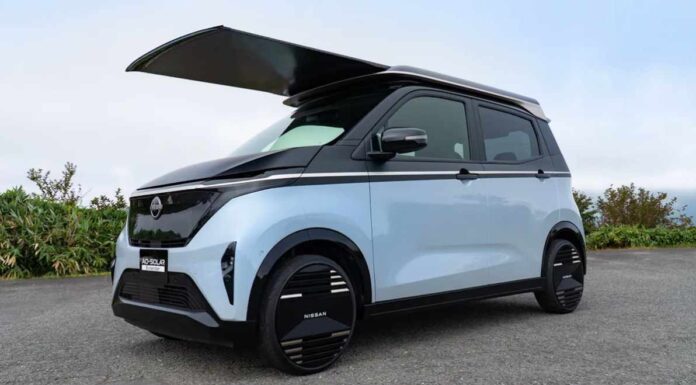- Nissan unveils the Ao-Solar Extender, an extendable solar roof for the Sakura EV.
- The panel generates up to 500 watts and can add 1,800 miles of free range yearly.
- The system works even in cloudy or rainy conditions and offers shade and backup power.
- A commercial launch is planned soon, with Nissan aiming to lead solar EV innovation.
Nissan is taking a bright step forward in sustainable mobility. The Japanese automaker has revealed a new solar roof system designed to extend the driving range of its most popular small electric vehicle, the Nissan Sakura. The technology, called the Ao-Solar Extender, will be officially showcased at the Japan Mobility Show later this month.
This innovative system uses sunlight to top up the EV’s battery. It features an extendable solar panel that can slide outward when the car is parked, effectively doubling the surface area available to capture energy. Nissan says the extended setup can produce up to 500 watts of power in optimal conditions.
The solar roof not only helps charge the vehicle but also provides extra shade to keep the cabin cool on hot sunny days.
Solar Energy That Works Even on Cloudy Days
Nissan engineers have designed the system to work in a variety of weather conditions. When fully extended, the Ao-Solar Extender can deliver up to 500 watts of electricity. On cloudy or rainy days, when the panel must remain retracted, it still generates about 300 watts. Even during the darkest and rainiest conditions, it can manage around 80 watts.
That may not sound like much, but Nissan says these small gains add up over time. The company estimates that the system can provide more than 1,800 miles of free electric range every year. For many drivers in Japan, that is enough to handle most daily errands without ever needing to plug into the grid.
The typical Sakura owner drives short distances around town, often for school runs or shopping trips. For these users, solar charging could almost eliminate the need for public charging stations or home electricity use. Nissan also points out that the system can provide an emergency power source during natural disasters, offering peace of mind for families in earthquake-prone regions.
A Practical and Eco-Friendly Innovation
The Sakura, Japan’s best-selling electric Kei car, already has a loyal following for its compact design and affordability. The addition of a solar roof makes it even more appealing to urban and eco-conscious drivers. The Ao-Solar Extender aligns perfectly with Nissan’s long-term strategy to promote zero-emission mobility across its range.
Despite its somewhat unconventional appearance, the solar panel system is not just a prototype. Nissan has confirmed that the technology is being prepared for commercial release. While the company has not shared an exact timeline, a launch is expected in the near future.
Nissan Joins the Race for Solar-Powered EVs
Nissan is not the first automaker to explore solar integration, but it may soon be one of the most practical. Other carmakers have tested similar ideas in recent years. Fisker, for example, offered a solar roof option on its Ocean SUV that could provide up to 1,200 miles of free driving per year. Hyundai and Toyota have also introduced systems that can add a few extra miles of range each day.
However, Nissan’s claim of 1,800 miles of solar-assisted range is impressive for a small city car. For people who drive short distances daily, this could mean little or no need to plug in. Owners might simply leave their vehicles parked in the sun to recharge naturally.
The technology also offers potential savings on electricity costs, especially in regions with high energy prices. It could be particularly attractive for those who leave their vehicles outdoors, allowing the panels to soak up sunlight throughout the day.
The Future of Solar Mobility
While solar panels on cars have often been treated as a futuristic concept, Nissan’s latest move shows how close this idea is to becoming mainstream. The company believes solar energy will play an important role in reducing charging demand and creating more self-sufficient vehicles.
Other brands are also exploring new directions in solar innovation. Mercedes-Benz recently introduced a prototype called the Vision EQ XX, featuring solar paint technology that acts as an active photovoltaic surface.
According to the company, this could add nearly 7,500 miles of additional range per year under ideal conditions. Mercedes has since showcased an updated version of this technology in its Vision Iconic EV concept, signaling that solar-based enhancements could soon appear in future production cars.
Nissan’s Ao-Solar Extender is a reminder that meaningful progress does not always require radical reinvention. Sometimes, clever engineering and practical design can bring futuristic ideas into the real world. As more automakers embrace renewable energy, the dream of driving on sunshine may soon become an everyday reality for millions of EV owners.
Follow TechBSB For More Updates

